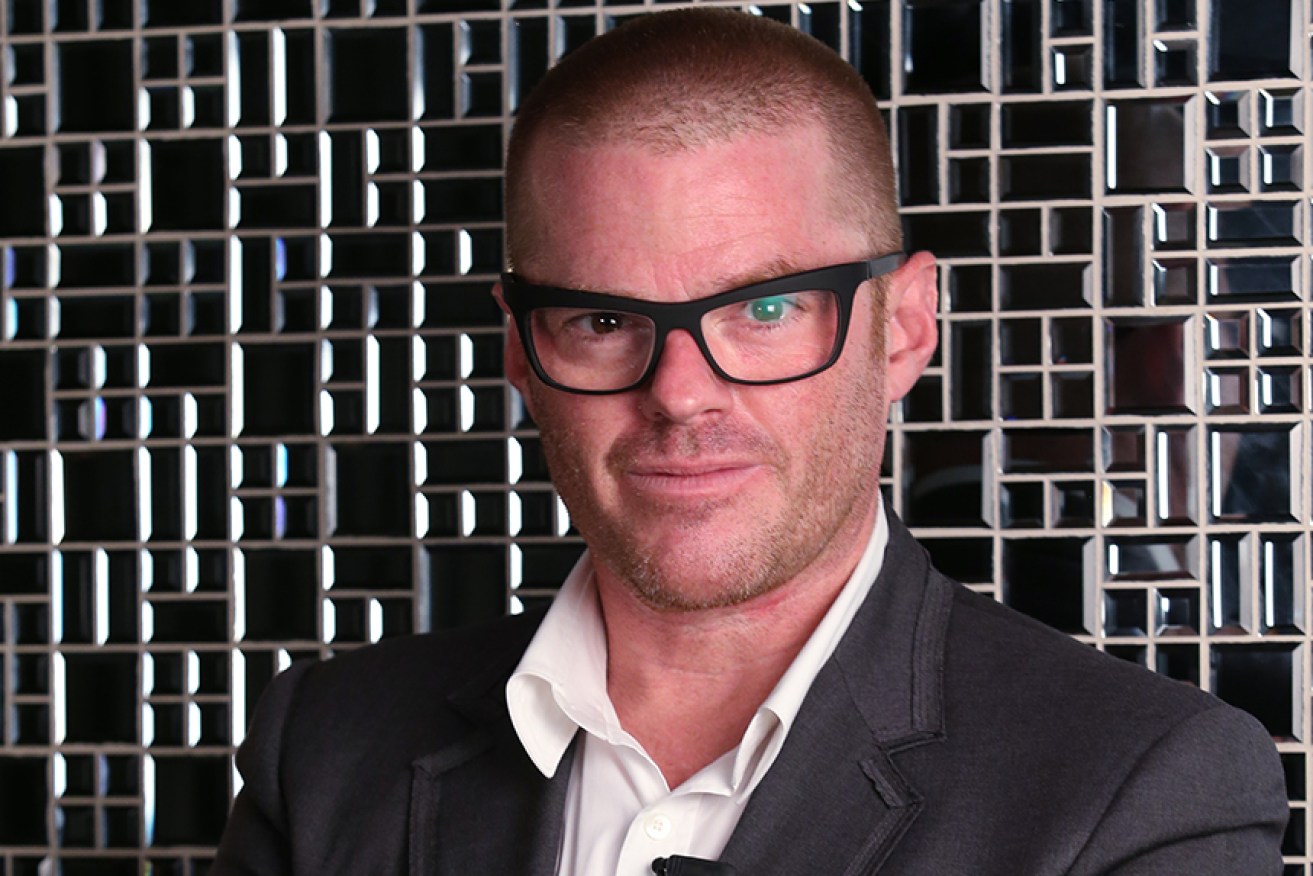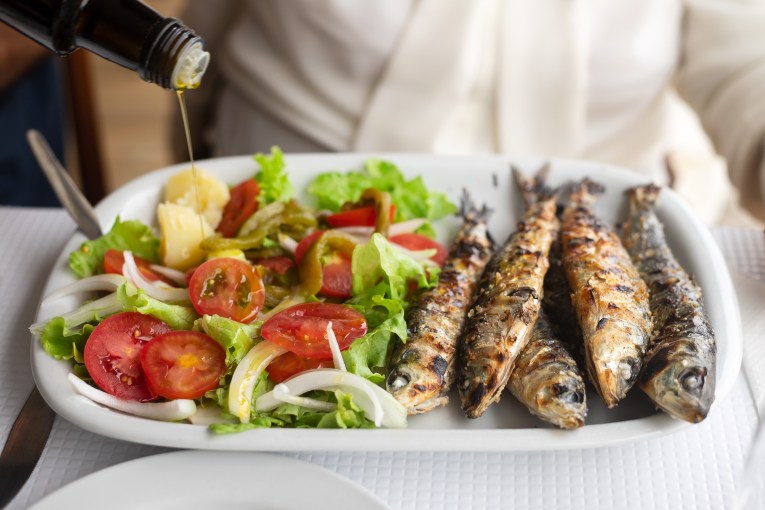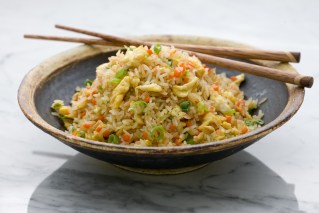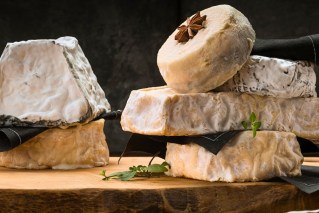How to make Heston’s egg … in 92 easy steps


Heston Blumenthal's Verjus in Egg comprises 92 steps. Photo: AAP
Feeling peckish and got a day or three to spare?
Then why not have a crack at making Heston Blumenthal’s diabolical Verjus in Egg which sent MasterChef finalists Matt Sinclair and Elena Duggan into hyper-ventilation in Tuesday night’s finale.

Heston’s Verjus in Egg. Photo: Network Ten.
The mind-bending recipe comes with a couple of warnings – it involves almost 100 elements and 92 steps.
So, take one egg … and get cracking.
Orange Biscuit with Feuillitine:
Pate a Bombe:
Crystallised Coffee:
Parfait:
Verjus “Egg Yolk”:
Coconut Panna Cotta:
Honey Tuile Nest:
Butter Mixture:
Kataifi Nest:
Kabosu Jelly:
Milk Chocolate Egg Layer:
White Chocolate Egg Layer:
Orange Candy Zest:
Vanilla Salt:
To create the egg shell and assemble the egg:
To assemble the Egg:
To assemble the dish:
Method:
- Preheat oven to 150C. Fill sous vide machine with water and set to 70C.
- For the Orange Biscuit with Feuillitine, combine flour, salt, vanilla and baking powder in a bowl and whisk well to combine.
- Place butter and sugar in the bowl of a stand mixer fitted with the paddle attachment. Start the machine on low for about a minute until the butter and sugar begin to combine. Increase the speed to medium until the mixture is pale and creamy, about 3 minutes.
- Reduce the mixer speed to low, add the egg yolk and grated orange zest, and mix until well combined. When combined, slowly add the flour mixture and mix until just combined. Be careful not to overwork the dough. Once mixed, form the dough into a disc, wrap with cling film and place into the fridge for 1 hour.
- Once chilled, remove the dough from the fridge. Roll out a portion of the dough between 2 sheets of baking paper to 2mm thickness, then place the dough, still between the baking paper, on a baking tray and transfer to the freezer for 15 minutes.
- Remove the sheet of dough from the freezer and peel away the top layer of baking paper. Sprinkle the surface of the dough with feuillitine flakes, then bake in the preheated oven for 14 minutes.
- Remove the biscuit from the oven and, using a 4cm round cutter, cut out several discs of biscuit. Place the biscuits on to a freshly lined baking tray, ensuring they remain flat. Place the tray in the oven to finish baking until biscuits are golden brown, about 6-8 minutes. Once baked, remove from the oven and allow to cool on the tray for 5 minutes, then transfer to a cooling rack until required.
- To make the Pâte à Bombe, place the water and sugar in a small saucepan and heat until the temperature reaches 118C.
- Meanwhile, place the egg yolk in the bowl of a stand mixer and whisk at medium speed until light and creamy.
- Once sugar syrup is at temperature, remove from the heat and, with the stand mixer on medium speed, gradually add the syrup to the whipped egg yolk by pouring in in a slow and steady stream down the side of the mixing bowl. Continue to whisk until the mixture has cooled and is a stiff, yellow foam.
- For the Crystallised Coffee, place the sugar and water in a medium saucepan and heat up to 150C.
- Remove from heat and immediately whisk in both coffee powders, Whisk vigorously until the mixture crystallises, about 2-3 minutes, and achieves a dry sand-like texture. Transfer to a tray and set aside on the bench to cool until required.
- For the Parfait, firstly combine the gelatine powder and the water in a small bowl and set aside to bloom.
- Place the verjus in a small saucepan, and reduce to a viscous syrup.
- Meanwhile, measure out the Citrus Reduction into a small bowl and set aside until required.
- When verjus is reduced, remove from heat and add to the Citrus Reduction stirring well to combine. Add the gelatine mixture and mix well until dissolved. Transfer to a bowl and set aside to cool until needed.
- Place the yoghurt and the cream in a bowl and whisk by hand until soft peaks form.
- Meanwhile, in a large, clean bowl, place 150g of cooled Pâte à Bombe, add the cooled verjus reduction mixture and fold gently to combine. Then fold in the whipped yoghurt and cream mixture and the Triple Sec.
- Add the Crystallised Coffee and fold through until evenly distributed.
- Spoon the mixture into a piping bag. Place a 3cm diameter silicone semi-sphere mould on to a baking tray and pipe the Parfait mixture into the moulds. Cover the moulds with cling film. Place the tray of parfait filled moulds into the blast chiller to freeze until firm.
- To put the first layer of speckle effect on to the chocolate egg shells, use the Brown Kirsch Speckle Effect spray. Holding the atomiser about 30cm from the poly carbonate half egg moulds, in several quick, sweeping motions, spray directly on to the surface of the moulds. Reserve this mixture for later use when finishing the egg. Set the moulds aside on the bench at room temperature to set completely.
- For the Verjus “Egg Yolk” place the infused mandarin purée, citrus reduction, Triple Sec and verjus in a large bowl and mix well to combine.
- Measure out 500g of the mandarin and verjus mixture into the jug of a Thermomix. Add the caster sugar and Malic Acid into the jug, set to 85C and speed 3 for 7 minutes. Turn on the machine and allow the mixture to come to temperature. If temperature has not reached 85C, continue to add time, 2 minutes at a time, until 85C is achieved.
- In the meantime, prepare a metal bowl over an ice bath.
- When the mixture reaches 85C, turn the machine off. Remove the lid and add the Gellan F. Replace the lid and begin blitzing the mixture at low speed for 1 minute, then blitz on high speed for 10 seconds. Stop the machine, lift the lid and scrape down the sides of the jug and blades. Set the machine to speed 8 and blitz for a further 2 minutes or until the mixture is fully incorporated.
- Put the mixture into a clean metal bowl and cool over an ice bath. Stir the mixture regularly until it is cold and fully set to a firm gel.
- Once the gel is fully cooled and set, place the gel into a clean Thermomix jug. Turn the machine on and gradually increase the speed to 8 then blitz on speed 8 for 2 minutes, scraping the lid and sides of the jug down every 30 seconds until the gel is completely smooth and combined. Rub a little of the gel between your fingers to check for any remaining graininess. If the gel is still slightly grainy, blitz for another minute and check again.
- Once the fluid gel is completely smooth, transfer to a medium metal bowl and place the bowl directly into a vac pac machine set on to the vacuum program. Close the lid and allow the fluid gel to rise to the top of the bowl, then press stop. Repeat this process until the fluid gel no longer bubbles and all air is removed.
- Once all the air is removed from the fluid gel, remove from the vac pac machine. Transfer to a piping bag and store on the bench until needed.
- To make the Coconut Panna Cotta, first mix the gelatine with 42g of the coconut water until gelatine has dissolved. Set the mixture aside to bloom.
- Place the milk, the remaining 100g of the coconut water, 25g of the coconut cream and the caster sugar in a medium saucepan over low heat and heat to 60C.
- Once at temperature, take the mixture off the heat and add the bloomed gelatine mixture. Use a silicone spatula and mix until the gelatine is fully dissolved. Set aside to cool slightly until needed.
- Meanwhile, place the yoghurt, coconut milk and the remaining 100g of coconut cream in a large bowl. Blitz with a stick blender for 30 seconds or until the ingredients are fully combined.
- Add the warm coconut mixture to the yoghurt mixture and stir with a silicone spatula until fully combined.
- Pass the mixture through a fine sieve and set over an ice bath to cool.
- Spray the blue silicone egg shaped moulds with canola oil spray. Place a silicone cup cake mould on to a deep baking tray. Sit the blue silicone egg shaped moulds in each hole, lining the holes with enough paper towel to keep the egg moulds upright. Once the panna cotta mixture is cool, fill the blue silicone egg shaped moulds to ¾ full. Fill the baking dish with iced water level with the top of the cup cake mould. Place the tray into the fridge and allow the Panna Cotta to set, about 40 minutes. Remove bowl of remaining mixture from ice bath to prevent setting and set aside on the bench until required.
- When the Panna Cotta in the moulds is set, remove from fridge. Use a small parisienne scoop, dipped in hot water, to take out several scoops from the centre of the panna cotta. Leave about 5mm of panna cotta all the way around the top edge of the mould.
- Pipe the Verjus “Egg Yolk” into the hollowed out panna cotta to the top of the hole. Cover over the yolk with reserved panna cotta mixture, filling the egg mould to 5mm from the top. Return the tray with the panna cotta moulds to the fridge until set, about 1 hour. Reserve any remaining Verjus “Egg Yolk” for assembly.
- To put the second layer of speckle effect on to the chocolate egg shells, use the Black Kirsch Speckle Effect spray. Holding the atomiser about 30cm from the poly carbonate half egg moulds, in several quick, sweeping motions, spray directly on to the surface of the moulds, over the Brown Speckle Effect. Reserve this mixture for later use when finishing the egg. Set the moulds aside on the bench at room temperature to set completely.
- To make the Honey Tuile Nest, first prepare the honeycomb. Place the isomalt, golden syrup, honey and water into a 7 litre saucepan and heat over medium heat to 160C. Brush down the sides of the saucepan with a wet pastry brush to prevent crystallisation.
- Once temperature is reached and while still on stove top, add the bicarbonate of soda and the verjus, whisking continuously as the mixture foams up. Remove the saucepan from the heat and pour the foaming mixture on to a silicon mat.
- Use a palette knife to spread the mixture evenly over the silicon mat and remove any bubbles. The surface of the honeycomb should be completely smooth. Allow the mixture to harden for about 5 minutes.
- Break off several chunks of honeycomb and transfer to a silicone mat under sugar lamps. Allow the honeycomb to sit on the mat under the lamps for about 15 minutes to soften.
- Once soft and pliable put on cotton gloves covered with latex gloves to handle the sugar lump. Use the silicone mat to push and fold the honeycomb over on to itself. Continue kneading the honeycomb with the mat until it no longer sticks to the mat. Then continue to knead with gloved hands, until a shiny, golden colour.
- Once the honey tuile mixture is a shiny, golden colour, use gloved hands to stretch and fold small amounts of the mixture at a time until it resembles a golden, shiny mass.
- Pull very small amounts of the tuile mixture into very thin threads and wind the threads gently around three fingers. Gently push the nests off your fingers and push the threads into a circular shape, about 3.5cm in diameter, to fashion into a nest.
- Place the nests on a tray lined with a silicone mat and place on the side to dry and set. Once dry enough to handle, carefully transfer the nests into an airtight container containing silica gel and set aside until needed.
- For the Butter Mixture, firstly melt the clarified butter. Place the rest of the ingredients into a large bowl and add the now melted, clarified butter and mix well to combine. Pass through a sieve into a clean bowl in preparation for the Kataifi Nest.
- To make the Kataifi Nest, place 50g of the Butter Mixture into a large bowl. Add the orange zest and stir together until well mixed.
- Add the kataifi pastry. Wearing latex gloves, gently mix the pastry into the butter mixture by hand until well coated. Place the entire nest mixture into a sous vide bag and vacuum seal. Place the sous vide bag into the water bath at 70C for 10 minutes.
- Meanwhile, line a baking tray with baking paper. Remove the nest mixture from the water bath, remove the pastry threads from the bag and using your fingers, break down the threads and shape into round nests, about 5cm in diameter, with a hole in the centre.
- Place the nests on to the baking tray and bake in the pre-heated oven for about 15 minutes, rotating the tray occasionally to ensure the nests are evenly baked and golden brown. Once baked, remove from oven and set aside on the baking tray to cool until needed.
- For the Kabosu Jelly, mix the pectin and fructose in a small bowl until well combined. Make a shallow well in the mixture and add the glucose. Set aside until needed.
- Place 333g of the kabosu juice, into a medium saucepan over low heat. Add the pectin mixture and bring the mixture to 105C.
- In the meantime, combine the citric acid and water in a small bowl and allow to dissolve. Once the glucose mixture has reached 105C, remove the saucepan from the heat and whisk in the citric acid mixture until well combined.
- Pour the mixture on to a 30 x 20cm tray lined with baking paper. Place the tray into the fridge to set, about 1 hour.
- Once the jelly has set, cut into very small cubes, 5mm x 5mm. Place the jelly cubes into an airtight container. And the remaining kabosu juice to the container and mix gently to coat the jelly cubes. Store the jelly in the fridge until needed to assemble the dish.
- To create the Milk Chocolate Egg Layer, remove the melted cocoa butter from the water bath and place in a medium bowl. Add the 3 food colours and use a stick blender to blend well until the colours are fully incorporated.
- Remove the melted milk chocolate from the water bath and add to the bowl of coloured cocoa butter. Stir well with a spatula to combine.
- To temper the chocolate mixture, pour ¾ of the warm, melted chocolate mixture on a clean, dry work surface. Agitate the mixture by scraping the chocolate back and forth along the surface until it thickens and reaches a temperature of 27C. Once at temperature, return the mixture to the bowl of remaining chocolate and continue to stir until it reaches 32C.
- Pass the mixture through a fine sieve and immediately pour the chocolate into an electric spray gun. Spray the chocolate directly on to the speckled egg shaped moulds, in a very thin layer. Scrape the excess chocolate away with a scraper. Turn scraped mould onto a cooling rack, upside down for 30 seconds, turn back upward, scrape again with a clean scraper and set aside on the bench.
- Reserve the milk chocolate mixture for later use when finishing the egg. Set the moulds aside on the bench at room temperature to set completely.
- To create the White Chocolate Egg Layer, remove the melted cocoa butter from the water bath and place in a medium bowl. Add the titanium oxide and use a stick blender to blend well until the colouring is fully incorporated.
- Remove the melted white chocolate from the water bath, add to the melted cocoa butter mixture and mix well with a spatula to combine.
- To temper the white chocolate mixture, pour ¾ of the warm, melted chocolate mixture on a clean, dry work surface. Agitate the mixture by scraping the chocolate back and forth along the surface until it thickens and reaches a temperature of 27C. Once at temperature, return the mixture to the bowl of remaining chocolate and bring to 32C.
- Once the Milk Chocolate Egg Layer has set completely, fill the egg moulds to the top with the tempered white chocolate. Lightly tap the side of the mould to realease any air bubbles. Turn the moulds upside down on a cooling rack and tap the sides of the mould gently to allow the excess chocolate to run off.
- Turn the moulds back over and scrape off the excess chocolate by running a metal scraper along the surface of the mould. Turn the moulds upside down once again to drain off excess chocolate for 30 seconds. Turn upright again and use a scraper to scrape clean the mould and neaten edges. Place the moulds upside down on a cooling rack. And place in the freezer for 10 minutes.
- Once the chocolate eggshells are set, carefully turn upside down onto a clean tray, gently tap mould to unmould eggshells and place them in a lined, uncovered, airtight container for about 5 minutes to allow to come to room temperature. Then cover until needed to finish the egg.
- To make the orange candy zest, ensure there is no pith remaining on the orange peel, then finely slice the orange peel into 1mm strips.
- Bring two small saucepans of water to the boil. Prepare a bowl of iced water. Once water is boiling, blanche the julienned orange peel for 5 seconds. Strain off then refresh the zest in iced water. Repeat this process once more with the second fresh batch of boiling water.
- In a separate saucepan, add the caster sugar, water, honey and blanched orange zest over a medium heat and cook to 114C.
- Remove the mixture from the heat and allow the zest to cool in the syrup. Once cool, transfer the zest and syrup into an airtight container and store in the fridge until required.
- To make the Vanilla Salt, scrape the seeds from the vanilla pods and discard the pods.
- In a small bowl, place the vanilla seeds and the salt and, using your fingers, rub together until the seeds are completely distributed through the salt. Set aside in an airtight container until required.
To assemble the Egg:
- Place a metal oven tray in a warm oven and allow to warm gently, before removing from the oven.
- Wear disposable gloves to assemble the egg.
- Remove the warm baking tray from the oven and sit on the bench top. Place one half chocolate egg shell, hollow side down, onto the warm tray for 1 second only, to melt the edges slightly. Then sit the half egg shell, with hollow side facing up, on a paper lined tray. Clean the tray and return to the oven.
- Remove the filled panna cotta in the egg shaped moulds from the fridge. Unmould the panna cotta by carefully squeezing the base of the moulds to release and, while doing so, lay the panna cotta directly into the top half of the chocolate egg shell, leaving space at the base of the egg for the parfait half sphere.
- Unmould the half spheres of frozen parfait and carefully dip them briefly into the bowl of liquid nitrogen.
- Place the frozen parfait into the base of the egg shell and push gently to join it to the base of the panna cotta.
- Remove the warm baking tray from the oven and sit on the bench top. Place the other half of the chocolate egg shell hollow side down onto the warm tray for 1 second only, to melt the edges slightly and seal the shell with the other half, enclosing the egg completely.
- Gently heat the reserved Milk Chocolate Egg Layer under the sugar lamps and carefully patch up the seal where the two halves of the egg shell join, ensuring there are no holes in the egg shell. Stand the finished egg in one of the silicone cup cake moulds and place in the blast chiller for 30 seconds.
- Stand the finished egg on to a small round cutter. Hold a metal sieve approximately 10cm above the egg and spray lightly with the Brown and Black Speckle sprays through the sieve all over the egg.
To assemble the dish:
- Place a dot of the reserved Verjus “Egg Yolk” in the middle of the bowl.
- Place an Orange Biscuit on top of the gel.
- Gently place the Kataifi Nest on top of the biscuit and position 3 pieces of orange candy zest within the nest so that they are still visible.
- Use tweezers to place several picked lemon thyme leaves between the strands of the nest.
- Top the Kataifi Nest with a Honey Tuille Nest.
- Drain some of the Kabosu Jelly cubes on paper towel to remove excess liquid. Place some of the jelly cubes around the nest. Drizzle a little of the kabuso jelly liquid from the container around the nest.
- Place the assembled egg on the nest.
- Place the Vanilla Salt in a ramekin to serve on the side.
- Just before serving the dish, drizzle about 5ml of liquid nitrogen directly on to the egg to help the egg shell to harden so that it “cracks” when struck with a spoon.
Eat & Drink
Cheap and tasty sardines saving lives
Eat & Drink








